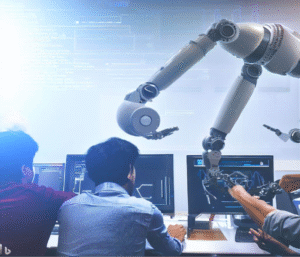AI in Testing: The Third Automation Wave
Last Updated: December 11th 2025
Is your testing strategy stuck in the past? Move beyond brittle scripts and high-maintenance frameworks. Schedule a consultation to future-proof your pipeline.
Software development does not move in a straight line. It moves in waves. Every decade or so, a fundamental shift occurs in how we build software, and consequently, how we must test it. We are currently standing at the precipice of the most significant shift since the invention of test automation itself. For a complete guide to using AI in Test Automation, refer to our master article here.
To understand where we are going in 2025, we must first understand how we got here. The struggles you face today, flaky tests, high maintenance costs, slow feedback loops, are not just technical annoyances. They are symptoms of using “Second Wave” tools to test “Third Wave” applications.
This article explores the evolution of software testing, defining the three distinct eras of automation, and explains why adopting Artificial Intelligence is not just a trend but the inevitable next step in the engineering lifecycle.
Table of Contents

The First Wave: Linear Verification (The Waterfall Era)
The First Wave of automation coincided with the era of monolithic applications and Waterfall development methodologies. In this period, software was released infrequently, perhaps once or twice a year.
Characteristics of the First Wave
Testing in this era was almost entirely manual or relied on basic “record and playback” tools that were rigid and unforgiving. The primary objective was verification. The requirements were defined months in advance, and the QA team’s job was to verify that the software met those static requirements before the “Gold Master” CD was burned.
Why It Ended
The First Wave collapsed under the weight of the Internet. As web applications began to replace desktop software, the ability to patch and update software instantly meant that release cycles shortened from years to months. The rigid, linear testing process became a bottleneck. You could not spend three months manually testing a web app that needed to be updated every three weeks.
The Second Wave: Continuous Execution (The Agile & DevOps Era)
To cope with the speed of the web, the industry entered the Second Wave. This is the era most organizations are currently struggling to exit. It was defined by the rise of Agile, DevOps, and open-source frameworks like Selenium.
Characteristics of the Second Wave
The primary objective of the Second Wave was speed of execution. The goal was to take the manual test cases from the First Wave and script them so they could run automatically every night.
This era gave birth to Continuous Integration (CI). We built massive grids of browsers to run thousands of tests in parallel. The logic was simple: if we can script it, we can run it fast. If we can run it fast, we can release fast.
The “Maintenance Trap”
While the Second Wave solved the speed problem, it introduced a new, more insidious problem: The Maintenance Trap.
Frameworks like Selenium rely on “selectors” (IDs, XPaths, CSS classes) to find elements on a page. However, modern front-end frameworks like React, Angular, and Vue utilize dynamic DOMs where element IDs change with every build.
This created a paradox. We wanted to release faster (Agile), so we automated everything. But because the application changed so fast, the automation scripts broke constantly. QA engineers stopped being testers and became “script repair technicians,” spending up to 50% of their time fixing broken tests rather than finding new bugs.
This is where the industry stalled. We had achieved speed, but at the cost of reliability. We needed a solution that was resilient to change.
The Third Wave: Cognitive Automation (The AI Era)
We have now entered the Third Wave. If the First Wave was about verification and the Second Wave was about execution, the Third Wave is about cognition and resilience.
This era is defined by the application of Artificial Intelligence and Machine Learning to the testing lifecycle. It moves beyond the rigid “if-this-then-that” logic of code-based scripts and introduces systems that can observe, learn, and adapt.
1. From Selectors to Visual Perception
In the Second Wave, a test script was blind. It only knew that Button_ID_123 existed. If that ID changed, the script failed.
Third Wave tools utilize computer vision and machine learning to “see” the application like a human does. AI-driven agents look at the screen and recognize a “Submit” button not just by its code ID, but by its shape, its text, its location relative to other fields, and its color.
This leads to Self-Healing Automation. If the ID changes but the button is still visually present and functional, the AI infers that it is the same element, adjusts the script in real-time, and continues execution. This capability is detailed further in our 2025 Guide to AI Testing Automation.
2. From Scripting to Generative Creation
The barrier to entry in the Second Wave was high. You needed to be a developer to write good automation code. The Third Wave democratizes this through Generative AI.
Large Language Models (LLMs) allow us to generate test scenarios using natural language. A Product Manager can describe a user flow, and the AI can generate the test steps. This shift is explored in depth in our article on How LLMs Are Reshaping QA. It allows teams to move from “How do I code this test?” to “What is the right test to write?”
3. From Deterministic to Probabilistic
The applications we build today are no longer just logical calculators. They are often AI-driven themselves, containing chatbots, recommendation engines, and personalized content.
You cannot test a probabilistic system with deterministic tools. The Third Wave introduces testing frameworks that can handle ambiguity and nuance. This is critical for organizations facing the need for AI apps testing, where the “correct” answer isn’t a single string of text but a sentiment or a range of acceptable outcomes.
Why You Cannot Ignore the Third Wave
Transitioning to the Third Wave is not merely about adopting cool technology. It is a strategic necessity for software engineering leaders.
The complexity of modern applications has outpaced the capability of human-scripted automation.
- Microservices mean dependencies are constantly shifting.
- Dynamic UIs mean static scripts are brittle.
- Rapid Releases mean there is no time for script maintenance.
Sticking to Second Wave tools in 2025 is the equivalent of using a physical map in the age of GPS. It might still work if you know exactly where you are going and nothing changes, but the moment there is a roadblock or a detour, you are lost.
How CloudQA Delivers the Third Wave
At CloudQA, we built our platform specifically for this new era. We recognized that simply adding more features to Selenium was not the answer. The answer was to rebuild the foundation of testing on intelligent architecture.
We enable the Third Wave by:
- Eliminating Brittle Scripts: Our AI “heals” broken tests automatically, slashing maintenance time by nearly 80%.
- Democratizing Access: Our low-code environment, powered by generative AI, allows anyone on the team to contribute to quality, not just SDETs.
- Unified Intelligence: We combine functional, API, and visual testing into a single, cohesive platform that learns from your application over time.
Conclusion
The Third Wave of automation is here. It promises a future where testing is no longer a bottleneck but a seamless, intelligent accelerator of value. It allows teams to stop fixing scripts and start improving user experiences.
The question is no longer “Should we adopt AI in testing?” but rather “How quickly can we transition?”
Frequently Asked Questions
Q: Does the Third Wave mean we stop writing code?
A: Not entirely. While low-code and AI generation reduce the need for boilerplate code, complex business logic may still require custom scripting. However, the focus shifts from writing basic interaction code to designing intelligent test architectures.
Q: Can I use Third Wave tools with my legacy applications?
A: Yes. AI-driven tools like CloudQA are often better at handling legacy applications than traditional scripts because they can adapt to older, clunky DOM structures without needing perfect identifiers.
Q: How does this impact the role of a QA Engineer?
A: The role evolves from “Test Executor” to “Quality Strategist.” Instead of spending hours maintaining scripts, engineers focus on test strategy, edge case analysis, and user experience optimization.
Related Articles
Share this post if it helped!
RECENT POSTS
Guides

How To Select a Regression Testing Automation Tool For Web Applications
Regression testing is an essential component in a web application development cycle. However, it’s often a time-consuming and tedious task in the QA process.

Switching from Manual to Automated QA Testing
Do you or your team currently test manually and trying to break into test automation? In this article, we outline how can small QA teams make transition from manual to codeless testing to full fledged automated testing.

Why you can’t ignore test planning in agile?
An agile development process seems too dynamic to have a test plan. Most organisations with agile, specially startups, don’t take the documented approach for testing. So, are they losing on something?

Challenges of testing Single Page Applications with Selenium
Single-page web applications are popular for their ability to improve the user experience. Except, test automation for Single-page apps can be difficult and time-consuming. We’ll discuss how you can have a steady quality control without burning time and effort.

Why is Codeless Test Automation better than Conventional Test Automation?
Testing is important for quality user experience. Being an integral part of Software Development Life Cycle (SDLC), it is necessary that testing has speed, efficiency and flexibility. But in agile development methodology, testing could be mechanical, routine and time-consuming.






